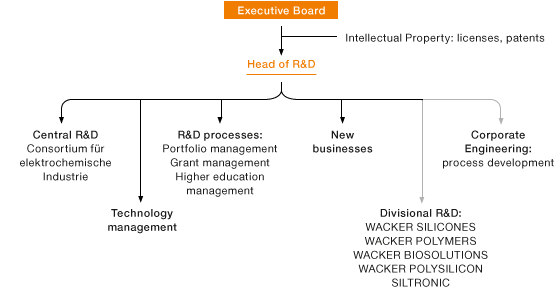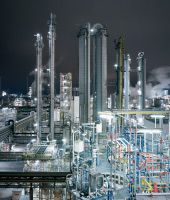Research & Development
WACKER’s research and development pursues three goals.
- Firstly, we search for solutions that meet our customers’ needs and contribute to their market success.
- Secondly, we optimize our processes in order to be the technology leader and to be sustainably profitable.
- Thirdly, we concentrate on creating innovative products and applications for new markets and on serving future trends, such as higher energy requirements, urbanization, digitization and growing prosperity.
R&D Expenses
| Download XLS |
|
|
|
|
||||||||||||
|
€ million |
2014 |
2013 |
2012 |
2011 |
2010 |
2009 |
2008 |
|||||||
|
|
|
|
|
|
|
|
|
|||||||
|
Research and development expenses |
183.1 |
173.8 |
173.7 |
172.9 |
165.1 |
164.0 |
163.2 |
|||||||
|
|
|
|
|
|
|
|
|
|||||||
In 2014, R&D expenses amounted to € 183.1 million (2013: € 173.8 million). At 3.8 percent (2013: 3.9 percent), the R&D rate – research and development spending as a percentage of Group sales – was down slightly from the previous year’s figure due to the positive sales trend.
New-Product Rate (NPR) 1

1 Percentage of sales accounted for by products launched in the last five years
We received about € 1.2 million from licensing agreements in 2014 (2013: € 7.3 million). The year-on-year reduction reflects the acquisition of a majority stake in Siltronic Samsung Wafer Pte. Ltd. in Singapore and the expiration of licensed patents. WACKER’s innovative strength is reflected in the number of patents held and patent applications submitted. In 2014, we filed 111 patent applications (2013: 123). Our portfolio contains about 5,200 active patents worldwide, as well as 2,100 patent applications currently pending.
Licensing Income

In 2014, WACKER invested € 7.8 million in R&D facilities (2013: € 5.9 million). This is a substantial increase over the prior-year figure and clearly affirms WACKER’s commitment to innovation. Among our investments in 2014 were new pilot plants where promising laboratory results are scaled up in an intermediate stage prior to full production. Examples include a plant in which we investigate the generation of trichlorosilane, and a new polymerization process. Further investment spending funded laboratory equipment to investigate full cells of lithium-ion batteries, for example. We have additionally invested in analytical equipment that will provide us with quick and precise results for use in the evaluation of experiments.
Investment in R&D Facilities

Breakdown of R&D Expenditures

Most of the € 183.1 million (2013: € 173.8 million) in R&D costs was spent on the development of new products and production processes. WACKER scientists are currently working on some 270 projects based on more than 40 technology platforms. Over 20 percent of these topics are key strategic projects, which account for 41 percent of all project costs (totaling € 71.5 million) incurred in 2014. WACKER operates in highly promising fields, ranging from energy, electronics, construction and automotive engineering to household and personal-care products, food and biotechnology. We launched the New Solutions initiative in 2013. Its goal is to develop technically and commercially superior solutions for new applications. Expertise from various areas in the company is consolidated groupwide and applied to projects as needed. In 2014, we worked on ten projects in this program. The market and technology evaluations conducted under the initiative revealed potential additional sales worth hundreds of millions. Initial solutions developed through the New Solutions initiative have already been placed with customers for application testing.
In 2014, we spent some € 768,000 (2013: € 170,000) on R&D expertise from third parties. The rise in these expenditures, which are distributed among three partners, is due to the acquisition of a know-how package.
Some of the research projects we completed in 2014 were subsidized by government grants. Here are two examples:
- In the Fusion Proteins project, the German Federal Ministry of Education and Research (BMBF) and the Bavarian Ministry of Economic Affairs, Infrastructure, Transport and Technology (STMWi) funded research on optimizing the industrial-scale production of proteins. This is being done through the secretion of fusion proteins in specific E. coli K-12 bacterial strains.
- In the Olefinic Fatty Acids project, the German Federal Ministry of Food, Agriculture and Consumer Protection (BMELV) funded work on new methods for cleaving, transforming and functionalizing olefinic fatty acids. We developed a method by which olefinic specialty chemicals can be manufactured.
During 2014, our business divisions and Central R&D submitted applications for eight more projects (in the areas of lightweight construction, energy storage, biologics and electronics) to government sponsors, with approvals pending. Our externally-funded research projects are coordinated by our Public Funding office, which evaluates candidate programs, submits our project proposals and manages contacts with funders.
Research and Development at Two Levels
WACKER conducts R&D at two levels: centrally at our Corporate Research & Development department and locally at our business divisions. Corporate R&D coordinates activities on a company-wide basis and involves other departments, such as Corporate Engineering (during process development). We also use a management process to keep our R&D projects transparent throughout the Group. In 2014, we further optimized the Project System Innovation (PSI) program we use to manage our projects, focusing on making the compiled data more relevant in terms of actual benefits for projects and the portfolio.
Strategic Collaboration with Customers and Research Institutes
Our business divisions conduct application-driven R&D. They focus on product and process innovations in semiconductor technology, silicone and polymer chemistry, and biotechnology, as well as on new processes for producing polycrystalline silicon. To achieve successful research results more quickly and efficiently, we collaborate with customers, scientific institutions and universities. In 2014, WACKER worked together with more than 40 international research institutes from three continents on some 50 research projects.
Our collaborative efforts cover topics that include electricity storage, biotechnology, process simulation and process development. In the field of process development, we have established new partnerships with universities in Munich and Stuttgart.
WACKER has also created a worldwide network of 21 technical competence centers that liaise between sales offices and local production sites. Specialists in these centers customize products to regional requirements, taking account of climatic conditions, national standards and local raw materials, for example. They develop formulations for customers’ new products and also optimize existing recipes.
Research Work at WACKER
As the center of WACKER’s R&D activities, Corporate R&D has the task of researching scientific correlations to develop new products and processes efficiently. Another task is to harness and develop new business fields that complement the Group’s core competencies.
R&D Organization

WACKER had 1,061 research and development staff in 2014, which represents 6.4 percent of the Group’s employees. Our scientists and engineers conduct basic research, develop new products and processes, and improve existing processes. The lab and technical staff at our R&D, applications-technology and production-support facilities work in our laboratories and in our production and pilot plants, or on-site at our customers’ plants. Our other R&D personnel construct research equipment in our workshops, or perform administrative functions in such fields as market research and trend analysis.
Employees in R&D as of December 31, 2014
| Download XLS |
|
|
|
|
||||||||||||||||
|
Number |
2014 |
2013 |
2012 |
2011 |
2010 |
2009 |
2008 |
|||||||||||
|
|
|
|
|
|
|
|
|
|||||||||||
|
||||||||||||||||||
|
Group R&D employees |
1,061 |
987 |
1,008 |
1,100 |
1,057 |
1,072 |
1,078 |
|||||||||||
|
R&D ratio1 in Group (%) |
6.4 |
6.2 |
6.2 |
6.4 |
6.5 |
6.9 |
6.8 |
|||||||||||
|
R&D employees, Germany |
833 |
817 |
849 |
868 |
855 |
860 |
836 |
|||||||||||
|
R&D employees, international |
228 |
170 |
159 |
232 |
202 |
212 |
242 |
|||||||||||
|
|
|
|
|
|
|
|
|
|||||||||||
|
R&D employees, Germany, by qualification |
833 |
817 |
849 |
868 |
855 |
860 |
836 |
|||||||||||
|
Scientists and engineers |
322 |
318 |
339 |
346 |
337 |
332 |
311 |
|||||||||||
|
Lab staff and technicians |
341 |
329 |
332 |
350 |
344 |
349 |
345 |
|||||||||||
|
Other personnel |
170 |
170 |
178 |
172 |
174 |
179 |
180 |
|||||||||||
|
|
|
|
|
|
|
|
|
|||||||||||
|
R&D employees, international, by qualification2 |
114 |
102 |
92 |
93 |
95 |
90 |
113 |
|||||||||||
|
Scientists and engineers |
45 |
38 |
32 |
35 |
31 |
30 |
34 |
|||||||||||
|
Lab staff and technicians |
37 |
34 |
32 |
30 |
32 |
29 |
34 |
|||||||||||
|
Other personnel |
32 |
30 |
28 |
28 |
32 |
31 |
45 |
|||||||||||
|
R&D employees, international, Siltronic AG only (without differentiation by qualification) |
114 |
68 |
67 |
139 |
101 |
122 |
127 |
|||||||||||
|
|
|
|
|
|
|
|
|
|||||||||||
Alexander Wacker Innovation Award
Wacker Chemie AG presented the Alexander Wacker Innovation Award to a project team in recognition of its pioneering work on WACKER’s proprietary ESETEC® 2.0 secretion system. The researchers conducted a fundamental analysis of the E. coli-based production system for pharmaceutical proteins, and made enhancements to it that enable even highly complex molecules such as antibody fragments to be produced cost-effectively and efficiently. Named after the company’s founder, the Alexander Wacker Innovation Award has been presented every year since 2006 – alternating between the categories of product innovation, process innovation and basic research. In 2014, the € 10,000 in prize money was awarded for innovation in basic research.
Siltronic Inventor Award
Siltronic AG confers its Inventor Award on employees who have delivered technological innovations. Eight employees received this award in 2014 for their imaginativeness and the systematic implementation of their inventions. In 2014, the two categories “Most Important Invention” and “Best Inventor” each awarded € 10,000 in prize money. With their projects, the award winners have optimized wafer-treatment processes.
Selected Corporate R&D Research Topics
Their good gas permeability makes silicones suitable as a membrane material for all kinds of applications. When combined with gas-selective materials, such membranes could be used for separating gases. The hydrophobic nature of silicone films combined with their high water-vapor permeability also makes them interesting as materials for textile applications and air-filtration systems. We are conducting tests in a development project to determine how such material systems might be used.
In the Si-HTF project, we are developing high-temperature silicon-based heat-transfer fluids for use in solar-thermal power plants with parabolic collectors. In contrast to those achievable with existing heat-transfer systems, these products should make higher operating temperatures possible in future systems, thus resulting in greater efficiency. This could lower the cost of electricity generation. One particularly beneficial feature of the new solution is its broad range of operating temperatures, which eliminates the need for expensive trace heating. We are also investigating their use in industrial heat-transfer applications.
Selected Divisional Research Projects
At WACKER SILICONES, research activity on electrically active silicone polymers was accelerated in 2014. Very thin films of these polymers lend themselves to energy recov-ery, and are also used for actuators and sensors. We are developing silicone resins that modify the proppants used in modern oil and gas production technologies. Novel silicone resins are also replacing organic binders in composites and synthetic stone. We are supporting new LED-based vehicle headlamp technologies by developing highly transparent silicone rubber compounds, which are used to make components for secondary optical devices. The additive manufacture of silicone parts in three-dimensional printing processes is another research field of the future.
During 2014, WACKER POLYMERS continued to focus its research on polymers that enable the formulation of low-emission end products that will meet the requirements of the most stringent ecolabels. In the spirit of sustainability, we have developed and improved products that are free of alkylphenol ethoxylate (APEO) surfactants and formaldehyde, and which are low in volatile organic compounds (VOCs). Examples include dispersible polymer powders based on VAE (vinyl acetate-ethylene copolymer) for cement applications and products based on VAE dispersions, such as those for carpet adhesives or for sealants. We have developed dispersible polymer powders based on PVC (polyvinyl chloride) copolymers for use as binders in dry-mix mortars. Our innovative entry-level products for construction applications such as cement and emulsion paints demonstrate our commitment to respond even more effectively to regional market requirements. High-performance processes continue to help us enhance our productivity.
WACKER BIOSOLUTIONS introduced nature-identical hydroxytyrosol for nutritional supplements. This antioxidant has therapeutic effects on blood pressure, joints and the immune and cardiovascular systems. As a free-radical scavenger, hydroxytyrosol can mitigate the effects of skin aging and lighten the skin. We have also developed products for nutritional supplements that enhance the bioavailability of active ingredients. Our researchers at Wacker Biotech enhanced the E. coli-based secretion technology for the production of pharmaceutical proteins. With ESETEC® 2.0, we now have an efficient method for producing high yields of antibody fragments for medical therapies. The method was first applied for the US company MedImmune, a subsidiary of AstraZeneca.
To improve the energy balance of solar cells and reduce costs, we are striving to reduce energy consumption in polysilicon production even further. WACKER POLYSILICON continued to optimize the processes in its closed production loop, once again reducing energy consumption during deposition and conversion. In the reporting year, we received the Bavarian state government’s Energy Award for our highly efficient polysilicon manufacturing operations. Thanks to patented technology advancements and process optimizations, we lowered our specific energy consumption for polysilicon production by 29 percent between 2005 and 2013. We made further improvements to surface conditioning for granular polysilicon so as to allow the product to be used for all industrial crystallization processes.
The performance of semiconductor devices doubles about every two years. Among the key performance-boosting parameters are the design rules achieved on a silicon wafer, which determine how many transistors fit on a device per square centimeter. Today, the semiconductor industry’s standard design rules are 22 and 16 nanometers (nm). In the coming years, they will decrease to 11 and eventually 8 nm. Siltronic is currently developing processes to produce 300 mm wafers that can be used for 11 and 8 nm design rules. In the reporting year, we started regular shipments of 11 nm wafers to our customers. We developed our 8 nm wafer technology further. We also worked on wafers for power and LED applications.
Transferring Knowledge Locally
Our WACKER ACADEMY locations serve as forums for industry-specific knowledge transfer between customers, distributors and WACKER experts. The focus is on industry-specific courses, which now cover silicone applications in addition to polymer chemistry, such as for cosmetics and paints. The training centers’ proximity to our development and test laboratories promotes the sharing of ideas and enables participants to conduct practical on-site tests. We work with company research facilities, universities and institutes to ensure our seminars remain state-of-the-art.
WACKER attaches considerable importance to fostering young scientific talent and maintaining close contacts with universities. In 2014, we sponsored some 200 final-degree theses and internships with students at over 50 universities internationally. In addition, Wacker Chemie AG and the Technische Universität München (TUM) extended their existing partnership in silicon research for another six years, with the agreement on the extension being signed by TUM and WACKER in February 2014. We are sponsoring the Institute of Silicon Chemistry, located on the research campus in Garching near Munich, with a total of up to € 2.5 million. This sum will finance doctoral positions and the associated material resources. WACKER and TUM founded the Institute of Silicon Chemistry in 2006. In recent years, more than 30 research projects have been conducted there, resulting in ten patents and over 35 scientific publications.
In 2014, WACKER partnered with the Technische Universität Berlin to organize an international scientific convention. The 17th International Symposium on Silicon Chemistry (ISOS XVII) and the jointly organized 7th European Silicon Days attracted some 600 researchers from the field of silicon and silicone chemistry to Berlin. During the convention, WACKER presented – for the 15th time – the WACKER Silicone Award for outstanding achievements in this area of research. The winner this time was Akira Sekiguchi, a professor of organic chemistry at the University of Tsukuba in Japan.
Key Product Launches in 2014
| Download XLS |
|
|
||||||
|
Product |
Description |
Application |
Sector |
|||
|
|
|
|
|
|||
|
ELASTOSIL® N9132s-KR |
Room-temperature-curing silicone rubber |
Adhesive and sealant for household appliances and electronic components |
Household appliances, electronics |
|||
|
ELASTOSIL® RT 728 |
Self-adhesive liquid silicone |
Production of media-resistant gaskets that withstand temperature extremes |
Automotive industry |
|||
|
ESETEC® 2.0 |
E. coli-based secretion technology |
Manufacture of proteins and antibody fragments for biologics |
Pharmaceuticals |
|||
|
GENIOSIL® XL 70 |
Arylalkoxysilane monomer |
Water scavenger for silane-crosslinking adhesive and sealant formulations |
Adhesives and sealants industry |
|||
|
HTEssence® |
Nature-identical hydroxytyrosol |
Antioxidant in food supplements, functional beverages, cosmetics |
Foodstuffs, cosmetics |
|||
|
SEMICOSIL® 871 TC |
Thermally conductive silicone rubber |
Attachment of control modules in automotive electronics |
Automotive sector |
|||
|
SEMICOSIL® 975 TC |
Thermally conductive silicone rubber |
Attachment of power electronic devices to heat sinks |
Electronics |
|||
|
VINNAPAS® 4220 L |
Dispersible polymer powder |
Self-leveling flooring compounds with a low VOC content (in line with environmental standard EMICODE® EC1+) |
Construction |
|||
|
VINNAPAS® 8620 E |
Dispersible polymer powder |
Modification of dry-mix mortars, formulation of low-emission tile adhesives |
Construction |
|||
|
VINNAPAS® 4417 N |
Formulation of tile adhesives specifically tailored to Brazil |
Construction |
||||
|
VINNAPAS® EF 3818 |
VAE dispersion |
Formulation of environmentally compatible, low-odor interior paints specifically for the Middle East and Africa |
Paints |
|||
|
WACKER® HC 321 |
Water-based silicone emulsion |
Water-based additive for reimpregnating outdoor clothing |
Household products, textiles |
|||
|
WACKER® HC 401 |
Solvent-based silicone emulsion |
Impregnant for professional textile laundering |
Dry cleaners |
|||
|
WACKER® SG 3377 |
Silicone-fluid-based low-temperature demulsifier |
Highly efficient release Agent for eliminating water during crude-oil production |
Petrochemicals |
|||



